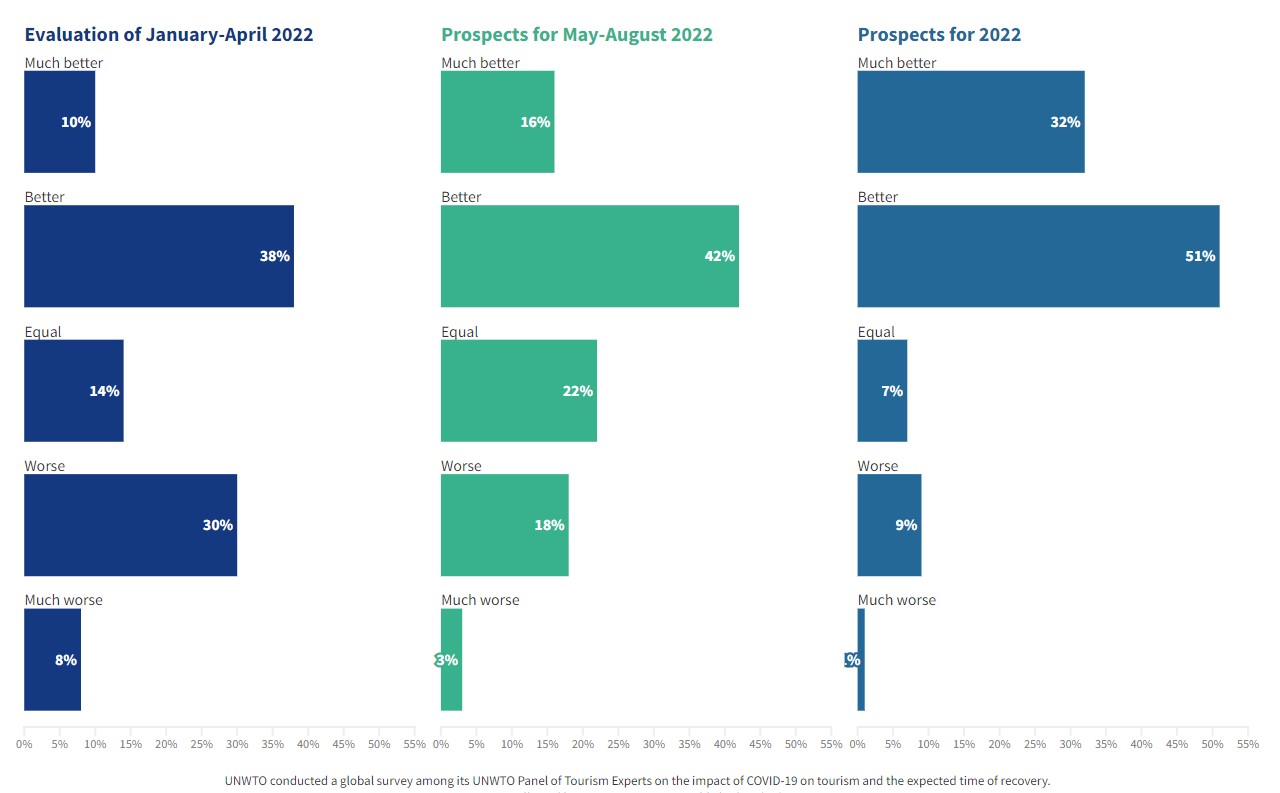UNWTO has raised its outlook for 2022 due to stronger than expected first quarter results, a significant increase in flight bookings and an improved outlook for the UNWTO confidence index.
International tourist arrivals are now expected to reach 55% to 70% of 2019 levels in 2022, depending on a number of circumstances, including the pace at which destinations continue to lift travel restrictions, developments in the war in Ukraine, possible further coronavirus outbreaks and global economic conditions, particularly inflation and energy prices.
According to the latest UNWTO World Tourism Barometer, international tourism continues to recover and saw a 182% year-on-year increase in January-March 2022, with destinations around the world receiving a total of 117 million international arrivals, up from 41 million in the first quarter of 2021. Of these 76 million additional international arrivals, some 47 million were recorded in March, showing that the recovery is gathering pace.
EUROPE AND THE AMERICAS LEAD THE RECOVERY
UNWTO data show that in the first quarter of 2022, Europe welcomed almost four times as many international arrivals (+280%) as in the first quarter of 2021, with the results driven by strong intra-regional demand.
In the Americas, arrivals more than doubled (+117%) in the same three months. Despite these very encouraging figures, arrivals in Europe and the Americas remained 43% and 46% below 2019 levels respectively.
The Middle East (+132%) and Africa (+96%) also saw strong growth in Q1 2022 compared to 2021, but arrivals remained 59% and 61% below 2019 levels respectively.
Asia-Pacific, meanwhile, saw a 64% increase over 2021, but levels were again 93% below 2019 figures as several destinations remained closed to non-core travel.
By sub-region, the Caribbean and southern Mediterranean Europe continue to show the fastest recovery rates. In both cases, arrivals have recovered to nearly 75% of 2019 levels, with some destinations reaching or exceeding pre-pandemic levels.
DESTINATIONS ARE OPENING UP
Although international tourism remains 61% below 2019 levels, the gradual recovery is expected to continue through 2022 as more destinations ease or lift travel restrictions.
Despite this positive outlook, the difficult economic situation, coupled with the Russian Federation’s military offensive in Ukraine, poses a risk to the recovery of international tourism.
The Russian offensive on Ukraine so far appears to have had a limited direct impact on overall performance, although it is disrupting travel to Eastern Europe and Asia, says the UNWTO.
However, the conflict is having a significant global economic impact, “exacerbating already high oil prices and general inflation and disrupting international supply chains, resulting in higher transport and accommodation costs for the tourism sector”.
REVENUES WILL RECOVER FASTER
Total tourism export revenues (including passenger transport) reached an estimated $713 billion in 2021, up 4% in real terms from 2020, but still 61% below 2019 levels.
However, the amount spent per trip is rising: from an average of $1,000 (€939) in 2019 to $1,400 (€1,303) in 2021.
A VERY POSITIVE OUTLOOK
The latest UNWTO confidence index also showed a clear improvement. For the first time since the start of the pandemic, the index has returned to 2019 levels, reflecting increased optimism among tourism experts around the world, supported by strong pent-up demand, particularly for intra-European travel and travel from the US to Europe.
According to the latest survey by the UNWTO expert group, an overwhelming majority of tourism professionals (83%) see a better outlook for 2022 compared to 2021, provided the virus is contained and destinations continue to ease or lift travel restrictions.
More experts (48%) now see a possible return of international arrivals to 2019 levels in 2023 (compared to 32% in the January survey), while the percentage saying this could happen in 2024 or later (44%) has decreased compared to the January survey (64%).
Assessment and outlook for tourism performance by the UNWTO Expert Group (Source: UNWTO – Template: Flourish Team)

Meanwhile, by the end of April, international air capacity in the Americas, Africa, Europe, the North Atlantic and the Middle East is at or near 80% of pre-crisis levels and demand is following suit.
Source & Photo: UNWTO








